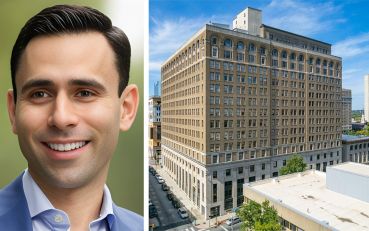On the Money: North Bridge’s Laura Rapaport Demystifies C-PACE
By Cathy Cunningham September 27, 2022 11:00 am
reprints
At an industry conference earlier this year, an attendee stood up at the end of a panel discussion, raised his hand and asked a question about the use of Commercial Property Assessed Clean Energy (C-PACE) financing in the capital stack. The four lender panelists sat silent for a moment until one humbly asked:
“What’s C-PACE?”
The sustainability-focused financing tool has been around since 2008 but still remains shrouded in mystery for many in the commercial real estate industry, even those who share a capital stack with it. But that’s where Laura Rapaport, founder of North Bridge, and her team come in.
As a C-PACE lender, North Bridge provides capital to an owner or developer to make energy-efficient improvements in a project. Those funds are then repaid through real estate taxes over the next 20 to 30 years. C-PACE can be used to fund renovations, new construction or — retroactively — to finance green projects completed up to three years prior.
Focus on environmental, social and corporate governance (ESG) skyrocketed during the pandemic — as both investors and tenants demanded more from the real estate industry — as did the use of C-PACE. More than 300 lenders — from banks to debt funds to insurance companies — have now consented to its inclusion in the capital stack, and that number is growing every day.
Rapaport got her career start in 2003 at Lehman Brothers Global Real Estate Group in London, where she helped introduce the U.K. real estate market to commercial mortgage-backed securities (CMBS). She’s also worked for Tishman Speyer and was a managing director for L&L Holding Company, where she was project director for 425 Park Avenue.
Commercial Observer sat down with Rapaport in early September to learn more about the green financing tool and why it’s only just now growing roots.
This interview has been edited for length and clarity.
Commercial Observer: Tell us about North Bridge.
Laura Rapaport: We’re a women-owned C-PACE lender and servicer, and we’re very much targeting the institutional market. Our differentiator is that everyone on the team comes from the institutional space, ranging from development to acquisitions to asset management to capital markets, so we’ve bought buildings and sold buildings and we’ve refinanced buildings.
What we think is so interesting about C-PACE, which is a really misunderstood form of financing, is that it can incentivize developers to build more efficient buildings, and, secondly, it can be a highly accretive financing tool to be used for refinances, rescue capital and even acquisition financing. At a time where there is so much volatility in the capital markets and people are pulling back, we’re leaning in, and we’re seeing tremendous opportunities across the country, ranging from rescue capital for hotels, office and retail assets to acquisition financing for student housing.
Talk us through what C-PACE can be used for in more detail.
Many projects are C-PACE-eligible by virtue of how they were built, or parts of them were built, and developers — candidly — often aren’t aware. For a new project, that includes your entire building envelope, your curtain walls, windows, doors, roofs, elevators, HVAC, electricity, seismic [measuring tools] on the West Coast to hurricane-resiliency measures in Florida, building management systems, and anything related to Local Law 97 in New York City. It’s not only the hard costs, but also the related soft costs. So, if you’re a building owner, and you are upgrading your boiler, windows and elevators, that whole project, that entire project will usually be PACE eligible, which is a huge surprise to people.
We spend a lot of time on education, not only helping people finance buildings but also talking to them about ways that can improve and increase their buildings’ sustainability. So, “Have you thought about electric vehicle charging, solar power, geothermal plants, or UV light filtration?”
How about the retroactive look-back for C-PACE financing?
Most states have a retroactive look-back that can be as long as three years. So if you have TCO in California within the last three years you can get C-PACE money today for what you previously spent. So, say you’ve built a hotel, or an office building or retail — certain projects that might not be as favorable right now from a financing standpoint — we can be up to 30 percent of the loan to value, based on dollars that were previously funded and the borrower can use it to pay down their existing debt.
C-PACE can also be used in terms of rescue capital with the benefit of look-back to pay down the senior loan, to blend and extend, pay the debt service and reserves, or it can be used for good news dollars for tenant improvements and leasing commissions.
Why do you think the real estate community within the U.S. has been so slow in terms of catching up to C-PACE use? It feels like Europe is way ahead of us.
I think C-PACE for a while was very mispriced, and it was way too expensive. It was also used for really small-scale projects, so a lot of institutional borrowers and lenders didn’t come into contact with it.
And, so, if you had a $200 million deal, and you had $4 million of C-PACE, it probably wasn’t worth your time. But, if you have a $200 million deal with $50 million of PACE, that’s a different story, and it becomes not only a very important financing, but also very accretive in terms of the relative value — whether that’s relative to the cost of the alternative financing, whether it’s senior or mezz or equity. C-PACE is cheaper than equity, and will help you get over your hurdles sooner.
C-PACE has actually been around since 2008, but it really saw its first wave of acceleration during COVID due to its retroactive nature, because it was financing that was available when a lot of the capital markets froze. Since then, the fact it’s now available in many more states than it used to be has also given it a lift, and there was so much money in the capital markets that people didn’t take the time to understand it before.
Do you think the COVID period gave us all time to stop and focus more on ESG, more generally?
I think what we’re starting to see, certainly on the U.S. side, is if people have certain mandates from their tenants or investors —who are national or international corporations with ESG goals — if you don’t have ESG measures in your building, you cannot get the tenant.
In terms of the U.S. catching up with Europe, we’re definitely farther behind in terms of laws that each city is putting into place, like Local Law 97, where cities are mandating certain levels of sustainability. It’s very hard on the borrower because a lot of times there isn’t liquidity available for [sustainability-focused renovations], which I think makes C-PACE a really attractive option.

Are there any downsides to using C-PACE?
No, I don’t think so. In order to do a deal, you need lender consent, but once you have it, if you don’t want it, you take it off. And, even in the case of bankruptcy or foreclosure, we step aside and the lender can step in. We are not predatory or loan-to-own money and we’re not 99 percent financing — we want a certain amount of equity in the deal. But I don’t really think there’s any particular risk because there are so many exits, and there are so many rights for both borrower and lender outside of the PACE.
Not every lender has consented to a ground lease, and C-PACE is a much more favorable form of financing in that, like a ground lease, the payment sits senior to the first mortgage and is paid out of the real estate taxes. But, unlike a ground lease, it’s fixed for the entire duration and it’s fully pre-payable in all or in part from the moment the funds are dispersed. You can quantify and market to tenants or your investors the energy savings, and it incentivizes people to put in more sustainable measures. Also, unlike mezzanine financing, it can never accelerate [a contract provision that allows a lender to require a borrower to repay all of an outstanding loan if certain requirements are not met]. That’s a big surprise to many people who say, “Oh, this is great, but you can fully accelerate it.” But, no, you cannot accelerate!
What are you hearing today from New York owners, in terms of their level of interest in C-PACE?
I have yet to meet an owner who doesn’t want to use this because it’s so highly accretive. The challenge with New York is the market is not open in that the documentation to close the transaction is not completed yet for New York City by NYCEEC, which the program administrator. Once that opens, I think it will be a tremendous opportunity for building owners, especially those in the office sectors, providing much-needed capital to upgrade their buildings — especially to make older buildings competitive with new construction.
For so many, this could be a very effective financing tool to upgrade New York’s infrastructure to where it needs to be — not only from a tenant attraction standpoint, but also from a carbon-reduction standpoint — and to create a much more efficient, much more sustainable infrastructure. In New York City, 70 percent of the carbon comes from real estate. It’s a shocking number. And so how can we incentivize owners to renovate and upgrade buildings in a way that will be effective, not only for now, but for the long term as we think about creating a more sustainable city?
When do you think New York will be open for C-PACE?
I’m not a betting lady.
What’s a typical deal size for North Bridge?
Our smallest deal is $7 million and our largest is over $150 million, although we can go higher. We’re most active at the moment as part of refinances, and we’re being asked, “What’s the maximum you can put into a deal to plug the hole?” because, whether they can’t get enough loan proceeds or there isn’t enough equity, we help fill the capital stacks. I would say a benefit of the North Bridge team is that we’ve sat in every seat — lender, borrower, developer, broker — and, as a result, we don’t think in the box. We think about it as, “How can we take this financing tool and use it to solve a complicated problem?”
What drove the launch of North Bridge?
I’ve always had an entrepreneurial mindset, even going back to selling the most boxes of Girl Scout cookies. That’s actually one of the things that attracted me to L&L, and, being able to see the growth of the company, I really wanted to do it myself. I felt really fortunate working on 425 Park, which is such a sustainable building, as I got to see the importance of biophilia. We were very much ahead of the curve, but it was clear to me that this was going to be something that was necessary.
When I first heard about C-PACE, I said, “Wow, this is really interesting.” I understood the need for it because I’ve been a borrower, developer and owner. I’ve refinanced projects in the middle of construction, and I’ve bought and sold projects. To me, it was such an interesting tool. I did my research and then I asked a bunch of people who are really smart, and no one had heard of C-PACE, so I saw a tremendous opportunity to not only make a difference, but also create a movement in the marketplace.
You got your start at Lehman Brothers in London and worked on several of the very first CMBS deals in the U.K. How was that experience?
It was like drinking from a firehose, but I was surrounded by really smart, incredible people. CMBS had been around in the U.S. for some time, but not in London. By the time we got to securitization seven, it was very different in a positive way because people were aware of the product.
And, so, I do think there’s similarities with C-PACE, where maybe 95 percent of people have no idea what it is today, but are now taking the time to figure it out. In London, people were asking legitimate questions, because they didn’t know what CMBS was, and we take the same mindset here of assuming everybody is starting from zero. It’s a new product to most people, and we don’t expect people to become experts immediately as it’s nuanced. As a result, we take the time to explain it because we think it can be such an effective tool for so many.
You’ve been heavily involved with New York Women Executives in Real Estate, known as WX, and have mentored several women along the way. What has that experience been like for you?
WX has been the single greatest organization I’ve ever been part of, and I can never give back as much as I’ve gotten from them. I was a scholar in business school and then I was on the membership committee, and on the board for five years. I stepped down when I started North Bridge, but it’s an incredible network of women, and I’ve gotten a lot out of the mentees that I have taken under my wing during my tenure with the organization.
Tara Stacom and Mary Ann Tighe are mentors of mine, and I consider myself really fortunate to have a couple of groups of women who are total rock stars by my side, and who I consider the secret to my success. I can ask them questions, we encourage each other, we help find people for their teams, we help them with problems, and we can really have an open conversation. Without them, I wouldn’t be where I am today.
To me, the strength of the organization is that people really want to help each other succeed and also help the next generation succeed. So, I think, as a result of organizations like WX, the role of women in our industry has become that much stronger and that much more ubiquitous.


